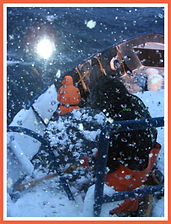Alaska
Crab Fishing

Have you ever choked at the price of crab on a menu when dining out? After learning of the danger and great lengths that a crab fisherman goes to, you'll happily shell out to crack into one of those succulent legs!
Roger Mumm, former Executive Chef at Henry's Great Alaskan Restaurant in Anchorage, is also a seasoned crab fisherman. Roger was kind enough to share with us some thrilling behind-the-scenes details of crab fishing life.

One thing is certain--crab fishing is not for the weary but rather for those seeking adventure and a HUGE adrenalin rush! A crab fisherman must be absolutely fearless. Falling into freezing waters, not far below the Arctic Circle, will afford a fisherman a mere 10 minutes of life! Considering it takes the boat 11 minutes to turn around...well, you get the chilling drift. With each outing, these men risk their very lives.
Likewise, crab fishermen must possess great stamina. Working long stretches that can reach 28 or more hours, the average amount of sleep is four hours per day. Working both day and night, sleep depravation is a serious risk and must be closely monitored. Fatalities in this industry are among the highest (per number of workers) of all U.S. jobs. Heavy machinery and gear pose additional threats.
A crab fisherman is constantly at the mercy of the rough -- and potentially deadly -- seas.


The particular crew that Roger works with gathers from all over, including Arizona and Bogotá, Columbia. The vessel they work on is one of only four crab boats that are "processing boats". Not only do they catch the crab, but they processes it right there on the boat. From the cage they cut, cook, freeze and package their crab so that upon returning to the docks--it's ready to ship to market! No small endeavor.


Average temperatures are 10-20 degrees Fahrenheit during the day and can quickly drop to 30 degrees below zero.

Ice is a constant battle and workers must remove it often. They start their scraping at the bow and work their way back. By the time they reach the stern, the bow has ice again!

All Alaskan crab fishing trips are regulated by the Alaska Department of Fish and Game. A representative is aboard on every trip, verifying that regulations and safety standards are maintained. Among other things, this person ensures that no female crab are harvested--only adult males. They ensure that trips are only made during open harvest periods and that there is no "by-catch" , meaning that nothing else is kept other than crab.

To give you an idea as to the amount of crab harvested, Roger quoted an Alaska King Crab run that brought in 267,000 pounds! An opilio (snow crab) run can average a million pounds (over four back-to-back trips).
Yummm....Alaska!